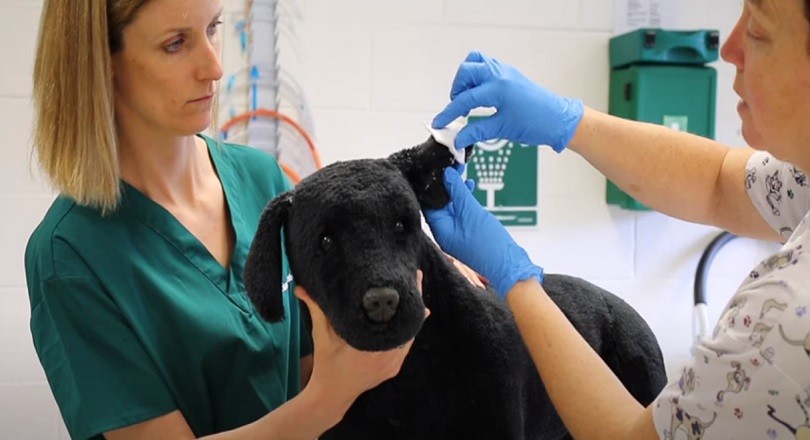Last Updated on February 28, 2025
Dog whistles typically emit frequencies between 23,000 and 54,000 Hz. These frequencies are above the human hearing range.
Dog whistles are valuable training tools for pet owners and dog trainers. They produce high-frequency sounds that dogs can hear, but humans cannot. This makes them ideal for silent commands and behavior reinforcement. The sound of a dog whistle can travel long distances, making it useful for recall training in open areas.
Additionally, the high-frequency sound can capture a dog’s attention without causing distress. It’s essential to use dog whistles responsibly, ensuring commands are consistent. Proper use of a dog whistle can enhance training effectiveness and strengthen communication between dogs and their handlers.
The Science Behind Dog Whistles

Dog whistles are fascinating tools. They leverage the unique auditory abilities of dogs. Understanding how they work can be enlightening for dog owners.
Auditory Range Of Dogs
Dogs hear sounds at different frequencies than humans. Humans hear frequencies between 20 Hz and 20,000 Hz. Dogs can hear frequencies between 40 Hz and 60,000 Hz. This extended range helps them hear high-pitched sounds.
This is why a dog whistle, which emits high-frequency sounds, is effective. The sound is often inaudible to humans but clear to dogs. This allows for silent commands and training.
Mechanics Of A Dog Whistle
Dog whistles are simple yet ingenious devices. They consist of a narrow tube with a small hole. Blowing into the tube creates a high-frequency sound wave. The frequency can be adjusted by changing the length or width of the tube.
| Component | Function |
|---|---|
| Narrow Tube | Produces the sound wave |
| Small Hole | Allows air to pass through |
| Adjustable Parts | Change the frequency |
Most dog whistles have adjustable parts. This lets you find the best frequency for your dog. It’s important to test different frequencies to see which one your dog responds to best.
Using a dog whistle is easy. Just blow into the whistle and observe your dog’s reaction. Over time, they will associate the sound with commands.
Dog whistles are a valuable tool. They make training easier and more effective. By understanding their science, you can use them more effectively.
Types Of Dog Whistles
Dog whistles come in various types to suit different training needs. Understanding the differences helps in choosing the right one for your dog.
Adjustable Frequency Whistles
Adjustable frequency whistles allow you to change the pitch. This flexibility is useful for training multiple dogs. You can find the frequency that best suits each dog.
- Customizable pitch
- Good for training different dogs
- Helps find the perfect frequency
Fixed Frequency Whistles
Fixed frequency whistles produce a consistent pitch. These are ideal for professional training. The same sound every time ensures clear commands.
- Consistent pitch
- Great for professional use
- Ensures clear commands
Training With Dog Whistles
Dog whistles are great tools for training your dog. They use high-frequency sounds that dogs can hear but humans can’t. These whistles can help in various training activities.
Effective Techniques
Using a dog whistle requires some practice. Start by choosing a specific command for each whistle sound. For instance:
- One short blow: Sit
- Two short blows: Come
- One long blow: Stay
Keep the training sessions short, around 5 to 10 minutes. Reward your dog with treats or praise each time they respond correctly. Consistency is key for effective training. Practice daily to reinforce the commands.
Common Mistakes To Avoid
Avoid these common mistakes to ensure successful training:
- Using the whistle too frequently. This can confuse your dog.
- Not being consistent with commands. Stick to the same sounds for each command.
- Skipping rewards. Always reward your dog for correct responses.
- Long training sessions. Keep sessions short to maintain your dog’s interest.
Remember, patience is essential. Training takes time and effort. Avoid getting frustrated if your dog doesn’t respond immediately. Stay calm and persistent.

Frequently Asked Questions
What Is The Best Frequency For A Dog Whistle?
The best frequency for a dog whistle is between 23,000 and 54,000 Hz. This range is optimal for training.
Do Dog Whistles Annoy Dogs?
Dog whistles can annoy dogs. Their high-frequency sound may cause discomfort or stress, especially if overused.
What Frequency Range Does A Dog Whistle Likely Have?
A dog whistle typically operates in the frequency range of 16,000 to 22,000 Hertz. This range is usually inaudible to humans but easily heard by dogs.
What Is The Difference Between 210.5 And 211.5 Dog Whistle?
The 210. 5 dog whistle emits a higher frequency sound compared to the 211. 5 whistles. This makes the 210. 5 whistle better for long-distance training, while the 211. 5 is suitable for closer range.
What Frequency Is A Typical Dog Whistle?
A typical dog whistle frequency ranges between 16,000 Hz and 22,000 Hz, which dogs can hear but humans usually can’t.
Conclusion
Understanding the frequency of a dog whistle helps in better training and communication with your pet. Dog whistles typically range from 23 to 54 kHz. Using the right frequency can make training more effective. Always consider your dog’s comfort and reaction when using a dog whistle for training.




